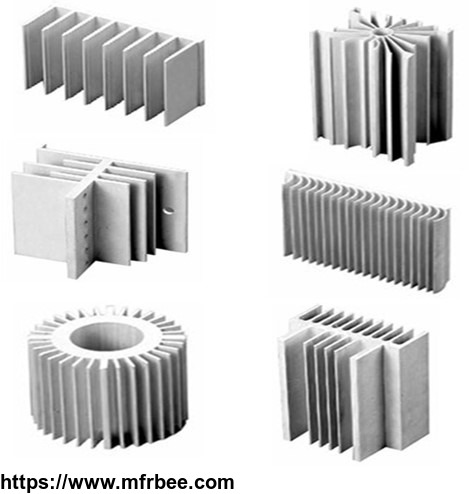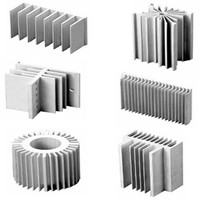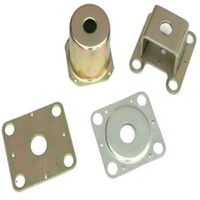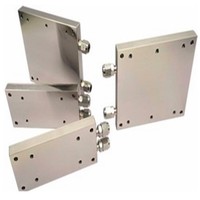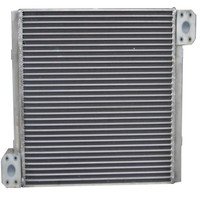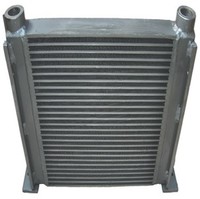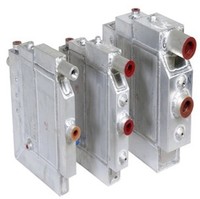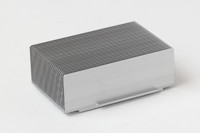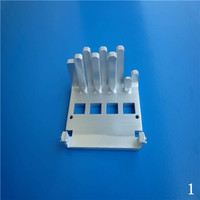Aluminum extrusion profile cooling heat sink
Product Quick Detail
- FOB Price
- USD $3,500.00 / Piece
- Place Of Origin
- China
- Minimum Order
- 1
- Packaging
- N/A
- Delivery
- 15 Days
Specifications
1. Product description
A heat sink is a passive heat exchanger that transfers the heat generated by an electronic or a mechanical device to a fluid medium, often air or a liquid coolant, where it is dissipated away from the device, thereby allowing regulation of the device's temperature at optimal levels. In computers, heat sinks are used to cool central processing units or graphics processors. Heat sinks are used with high-power semiconductor devices such as power transistors and optoelectronics such as lasers and light emitting diodes (LEDs), where the heat dissipation ability of the component itself is insufficient to moderate its temperature.
A heat sink is designed to maximize its surface area in contact with the cooling medium surrounding it, such as the air. Air velocity, choice of material, protrusion design and surface treatment are factors that affect the performance of a heat sink. Heat sink attachment methods and thermal interface materials also affect the die temperature of the integrated circuit. Thermal adhesive or thermal grease improve the heat sink's performance by filling air gaps between the heat sink and the heat spreader on the device. A heat sink is usually made out of copper or aluminium. Copper is used because it has many desirable properties for thermally efficient and durable heat exchangers. First and foremost, copper is an excellent conductor of heat. This means that copper's high thermal conductivity allows heat to pass through it quickly. Aluminium heat sinks are used as a low-cost, lightweight alternative to copper heat sinks, and have a lower thermal conductivity than copper.
2. Specification
2.1. Material
AA6000 series like 6061,6063
2.2. Temper
T3/T5/T6
2.3. Dimension
Length up to 1000 mm; Width up to 500mm; Height up to 500mm
2.4. Shape
Square,rectangle, round or custom shape
2.5. Surface finish
Powder coating, oxidation, or mill finish
2.6. Color
Black, red, green,white are typical
3. Packing way
To be packed in plywood case
4. Application
Widely used in heat transfer, electronics and industrial fields
A heat sink is a passive heat exchanger that transfers the heat generated by an electronic or a mechanical device to a fluid medium, often air or a liquid coolant, where it is dissipated away from the device, thereby allowing regulation of the device's temperature at optimal levels. In computers, heat sinks are used to cool central processing units or graphics processors. Heat sinks are used with high-power semiconductor devices such as power transistors and optoelectronics such as lasers and light emitting diodes (LEDs), where the heat dissipation ability of the component itself is insufficient to moderate its temperature.
A heat sink is designed to maximize its surface area in contact with the cooling medium surrounding it, such as the air. Air velocity, choice of material, protrusion design and surface treatment are factors that affect the performance of a heat sink. Heat sink attachment methods and thermal interface materials also affect the die temperature of the integrated circuit. Thermal adhesive or thermal grease improve the heat sink's performance by filling air gaps between the heat sink and the heat spreader on the device. A heat sink is usually made out of copper or aluminium. Copper is used because it has many desirable properties for thermally efficient and durable heat exchangers. First and foremost, copper is an excellent conductor of heat. This means that copper's high thermal conductivity allows heat to pass through it quickly. Aluminium heat sinks are used as a low-cost, lightweight alternative to copper heat sinks, and have a lower thermal conductivity than copper.
2. Specification
2.1. Material
AA6000 series like 6061,6063
2.2. Temper
T3/T5/T6
2.3. Dimension
Length up to 1000 mm; Width up to 500mm; Height up to 500mm
2.4. Shape
Square,rectangle, round or custom shape
2.5. Surface finish
Powder coating, oxidation, or mill finish
2.6. Color
Black, red, green,white are typical
3. Packing way
To be packed in plywood case
4. Application
Widely used in heat transfer, electronics and industrial fields
- Country: China (Mainland)
- Business Type: Manufacturer
- Market:Africa,Americas,Asia,Emerging Markets,Europe,European Union,G20,Middle East,Oceania
- Founded Year:2014
- Address:NO.12 EAST MOZHOU ROAD, JIANGNING DISTRICT, NANJING
- Contact:Frances Cai
Other products from NANJING METALLI INDUSTRIAL CO., LIMITED
Relate products of Aluminum extrusion profile cooling heat sink
extrusion aluminum heat sink cooler
extrusion heat sink Biggest width 700MM Process CNC milling and turning, drilling, grinding, bending, stamping, tapping Tolerance 0.05mm~0.1mm DRW format PDF/DWG/IGS/STP/ etc Equipment CNC machining center, CNC turning, General milling machines.Soldering oven Capacity: 10,0000 ...
aluminum extrusion heat sink Aluminum Consruction Heatsink
Dongguan Shengjia Hardware Products Co.,Ltd is one of the best China aluminum consruction heatsink manufacturers with professional factory, which is able to produce custom aluminum consruction heatsink at competitive price. Quick Details Place of Origin: Guangdong, China ...
